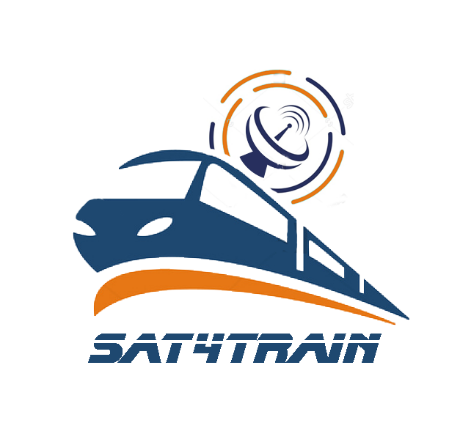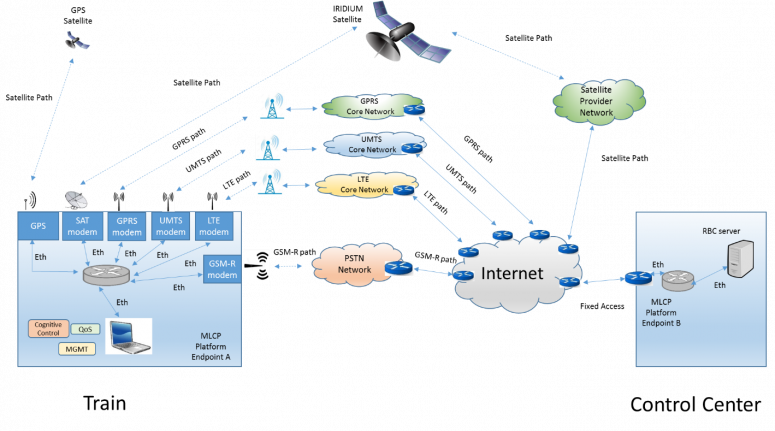
-
StatusOngoing
-
Status date2018-06-26
The main objective of Sat4Train is to develop a Multi Link Communication Platform (MLCP) able to use all the available terrestrial and satellite public communication services providing an innovative solution, especially for regional and in general low-traffic lines, where dedicated networks (i.e. GSM-R) are not economically sustainable.
The onboard the train and the ground backend of MLCP is able to establish an end-to-end reliable communication, using multiple bearers in parallel. Such architecture is tested on a real railway environment, guaranteeing the quality of service and fulfilling the railway requirements, despite the used communication channels are not dedicated.
On the technical point of view the goal is to adopt a Multipath-TCP protocol in conjunction with specific cognitive algorithms, allowing bearers selection and load balancing on a predictive-model basis, taking into account different priorities and quality of services and choosing the most convenient channels.
One of the most critical aspects is to reach the QoS target even in the absence of dedicated networks and achieve this goal in all operating conditions.
Another very challenging aspect is to obtain an adequate predictive ability in a context where so many parameters can vary simultaneously, and this context is an interested application of cognitive mechanisms to achieve a smart routing capability
This product has the potential to provide a very cost effective solution, especially in local and regional railway lines, where dedicated networks (e.g. GSM-R) require big investments in fixed infrastructures, representing a barrier to the railway modernization, since the train traffic is not so heavy to justify such investments.
The MLCP solution offers a real bearer independency, not requiring specific radio access technologies and operating with greater autonomy from the application layer. Such product guarantees interoperability with legacy solutions (i.e. GSM-R) and thanks to the Satcom is able to offer all the communication services even in case of particular congestion of all the PLMNs.
The Sat4Train solution is mainly based on the MLCP, an IP-based smart routing platform able to provide bearer-independent train-to-trackside mobile communication for the railway applications.
It allows traffic prioritization, guaranteeing the reservation of the maximum performances to the railway signalling bi-direction data communication between the onboard the train (i.e. ETCS/EVC) and the control centre (i.e. RBC) .
It is able to integrate heterogeneous wireless technologies such as Satellite Communication and Public Land Mobile Networks (PLMNs) and it can switch to legacy solutions (i.e. GSM-R) in areas already covered by such dedicated networks.
The MLCP technology is ready to integrate also future voice services (i.e. Voice over IP ), once they will be defined and standardized inside the European railway stakeholders community.
The MLCP is composed by two main elements (end-points):
• the on board train platform:
• the back end platform
The on board platform is connected to the ETCS On board Unit (EVC), while the trackside back end is connected to the Radio Block Centre (RBC).
The functional high level architecture of the Sat4Train is depicted in the following figure:

One of the key MLCP technology is constituted by its software, implementing the smart algorithms for both the on-board and the backend equipment.
MLCP provides very efficient end-to-end data transfer and vertical handover by means of MP-TCP (Multipath TCP) which is an extension of TCP protocol to handle multiple paths between two endpoints.
MPTCP splits the transport layer in two sublayers: the upper one responsible of the connection management (establishing connection, reordering packets, etc.), and the lower one gathering a set of simultaneous sub-flows that can be seen as parts composing the same TCP flow.
All these simultaneous parallel data sub-flows can be routed over more independent bearers, associated to different radio access technologies and/or mobile operators, each one offering its services on a best effort basis. The routing policy can be defined to obtain redundancy or, in alternative, load balancing over such paths.
On the basis of all the key QoS parameters, associated to each bearer, gathered and processed in real-time, the MLCP adopts some specific cognitive algorithms to define and tune a predictive model to support the bearers selection and the vertical handover.
The project plan starts from an Analysis phase, aiming to reach the first milestone that is the Baseline Design Review (BDR), with the goal to consolidate the first Technical Specification (Requirements & Functional Specifications), the High-Level Architecture Design and the first issue of the Business Plan.
The following phase is constituted by Architecture Design phase, in which the Technical Specification and the TLC System Architecture Design are completed, along with the second issue of the Business Plan. An evaluation of the system performance by simulation supports these system design activities. The completion of such activities constitutes the second milestone, that is the Mid Term Review (MTR).
At this point, the project foresees the real development of the MLCP, the integration and the laboratory testing of both the respective onboard and the control centre end points, delivering the prototypes and all the related documentation. This represents the Factory Acceptance Tests milestone.
These activities are conducted in parallel to a Measurement Campaign in a real railway environment, aiming to collect data about the Radio Coverage and to define the KPI for each single bearer.
On this basis the Field Testing Verification and Design Review phase can follow, along with some dissemination activities, reaching the last milestone of the project represented by the Final Review Milestone.
At present, Sat4Train Project reached the Baseline Design Review milestone, defining the first issues of the Technical Specifications (Requirements & Functional Specifications), the Design & Analysis Document (High-level Architecture Design), the Business Plan and the Design Verification Matrix.




